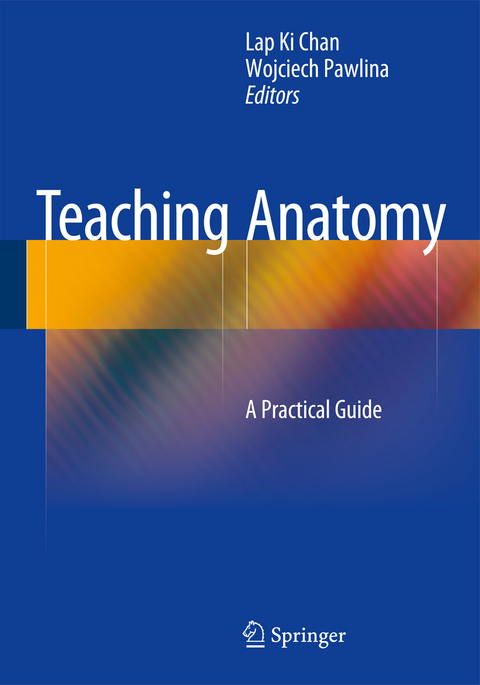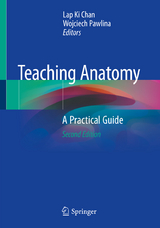
Teaching Anatomy
Springer International Publishing (Verlag)
978-3-319-08929-4 (ISBN)
- Titel erscheint in neuer Auflage
- Artikel merken
Lap Ki Chan, BSc (Biomed), MB,BS (HK), FHKCOS, FHKAM, FRCS Edinburgh, PhD (Duke) Assistant Dean (Education) Deputy Director of Institute of Medical and Health Sciences Education Associate Professor in Institute of Medical and Health Sciences Education and Department of Anatomy Li Ka Shing Faculty of Medicine The University of Hong Kong Dr. Chan has extensive experience in faculty development. He is the educator for the Asia Pacific region for AOTramua (the Swiss foundation which invented the original screws, plates and other instrument for fracture fixation), responsible for teaching orthopaedic surgeons in the region how to teach. He is the director of the Staff and Professional Development Programme in the Li Ka Shing Faculty of Medicine at The University of Hong Kong. Wojciech Pawlina, M.D. Chair, Department of Anatomy Professor of Anatomy and Medical Education Assistant Dean for Curriculum Development and Innovation College of Medicine, Mayo Clinic Dr. Pawlina is the co-editor-in-chief of Anatomical Sciences Education, the number one journal in the category of “Education, Scientific Disciplines” in JCR.
lt;p>1. Elements Of Successful Adult Learning.- 2. Characteristics Of Students Of The Millennial Generation.- 3. Students Learning Styles In Anatomy.- 4. Outcome-Based Approach To Student Learning.- 5. Competencies Needed For Teaching Anatomy Effectively And Efficiently.- 6. Using Teaching Assistants In Anatomy.- 7. Engaging Residents And Clinical Faculty In Anatomy Education.- 8. Giving A Lecture.- 9. Engaging Students In Active Learning In The Large Group Setting.- 10. Preparing and Recording Lectures For On-Line Delivery.- 11. Evaluating Your Own Performance In A Lecture.- 12. Choosing Between Lecture and Briefing Session.- 13. Facilitating Small Group Discussion.- 14. Engaging Students With Different Learning Styles And Behavioral Problems.- 15. Promoting The Learning Of Anatomy In PBL Environment.- 16. Promoting The Learning Of Anatomy In CBL Environment.- 17. Promoting The Learning Of Anatomy In TBL Environment.- 18. Giving Feedback To Students.- 19. Using Body Painting To Teach Anatomy.- 20. Evaluating Your Own Performance In Leading A Small Group Discussion.- 21. Running A Body Donation Program.- 22. Designing Gross Anatomy Laboratory To Meet The Needs Of Today's Learner.- 23. Preparing Students Emotionally For The Human Dissection Experience.- 24. Promoting Reflection In The Laboratory.- 25. The Pros And Cons Of Dissection And Prosection.- 26. Use Of Fresh Specimens In Anatomy Teaching And Learning.- 27. Instruments For Facilitating Anatomy Learning In The Laboratory.- 28. The Use Of Digital Human Models.- 29. Essential E-Learning and M-Learning Methods for Teaching Anatomy.- 30. The Use Of Low-Tech Models To Enhance The Learning Of Anatomy.- 31. The Use Of The Gross Anatomy Museum For Teaching And Learning.- 32. Different Methods For Assessing Anatomical Knowledge.- 33. Writing Good Questions In Anatomy.- 34. Assessing Non-Discipline Related Skills And Competencies.- 35. The Anatomy Components In Different Types Of Curricula.- 36. The Role Of An Anatomist In A Healthcare Curriculum.- 37. Identity Of Anatomy Teacher In An Integrated Curriculum.- 38. Hidden Curriculum In Anatomy.- 39. Dental Program.- 40. Allied Health Program.- 41. Research Methods In Anatomy Education.- 42. Educational Research Opportunities In Anatomy.
| Erscheint lt. Verlag | 25.2.2015 |
|---|---|
| Zusatzinfo | XX, 403 p. 162 illus., 127 illus. in color. |
| Verlagsort | Cham |
| Sprache | englisch |
| Maße | 178 x 254 mm |
| Gewicht | 750 g |
| Themenwelt | Studium ► 1. Studienabschnitt (Vorklinik) ► Anatomie / Neuroanatomie |
| Schlagworte | Educational skills • Gross anatomy • Healthcare curriculum • Pedagogic methods |
| ISBN-10 | 3-319-08929-3 / 3319089293 |
| ISBN-13 | 978-3-319-08929-4 / 9783319089294 |
| Zustand | Neuware |
| Informationen gemäß Produktsicherheitsverordnung (GPSR) | |
| Haben Sie eine Frage zum Produkt? |
aus dem Bereich



